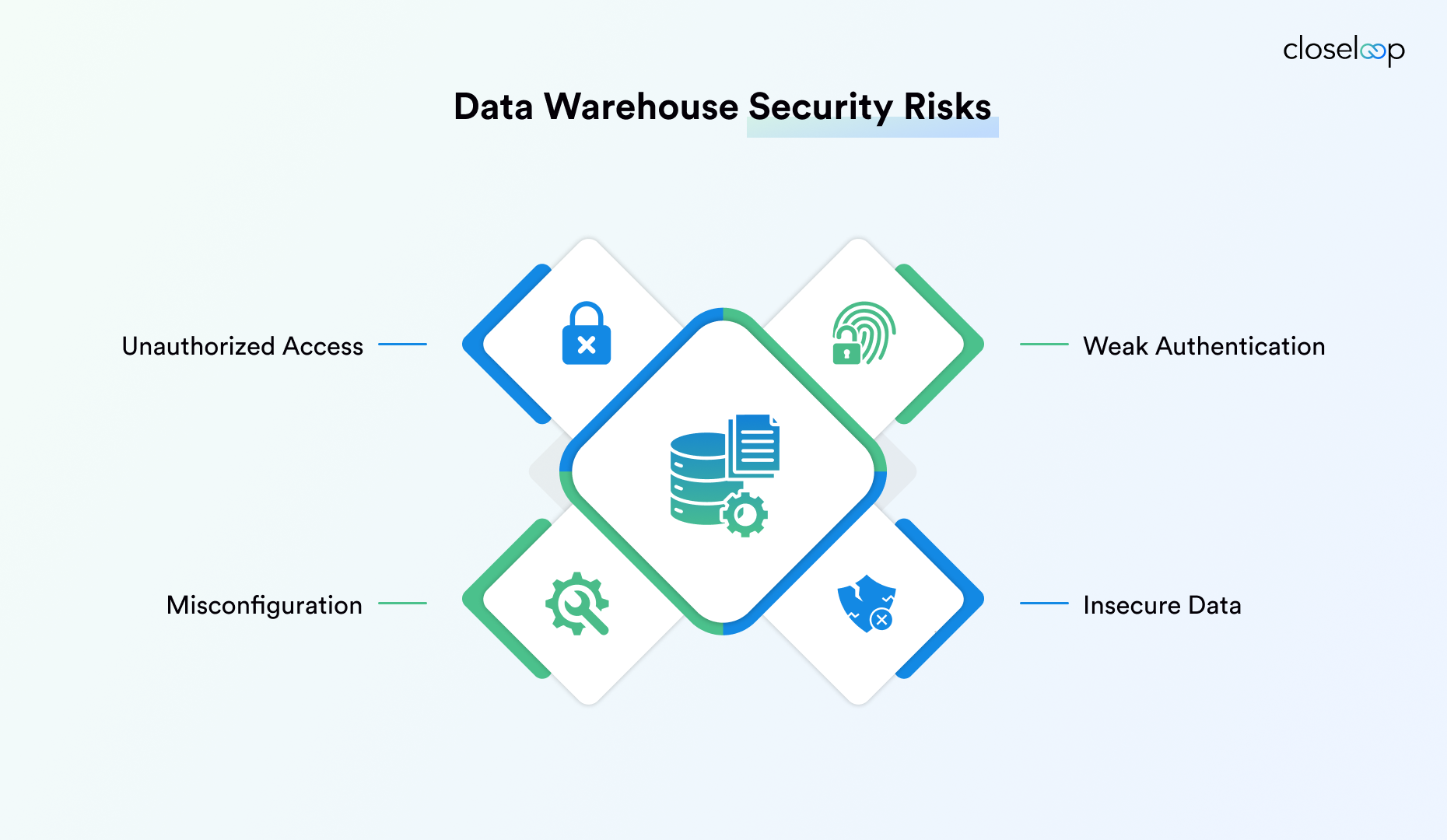If you are running a modern enterprise, your data warehouse is one of your most valuable assets and also one of your biggest security risks. Strengthening data warehouse security is no longer optional. It is where sensitive records, financial data, customer details, and business intelligence all converge. That centralization gives you the insights you need to operate at scale, but it also makes your warehouse a prime target for cyber threats.
You have likely seen the headlines that attackers no longer go after small pockets of data. They aim for centralized systems where a single breach can expose millions of records. With the growth of cloud adoption, the attack surface has expanded. Misconfigurations, third-party integrations, and weak access practices create openings. And even with the best technology stack, insider threats and data encryption gaps in data warehouses can quietly undermine your defenses.
The impact of poor data warehouse security isn’t limited to the breach itself. Regulatory bodies have tightened enforcement, and penalties under GDPR, HIPAA, or PCI-DSS are only getting steeper. Beyond compliance, there’s the reputational damage, where partners, customers, and even your own teams lose confidence when data is mishandled. On the operational side, a compromised warehouse disrupts reporting and decision-making right when you need clarity most.
In this blog, I’ll walk you through the common data warehouse security issues, the compliance pressures that make stronger controls essential, and the data warehouse security best practices that actually hold up under enterprise demands. My goal is not to overwhelm you with jargon, but to give you a clear picture of how to secure a data warehouse environment that’s resilient, compliant, and trusted.
By the end, you’ll know how to avoid data warehouse security issues, which risks to look out for, and how leaders are shaping security-first warehouse strategies. And if you want a partner that understands both the engineering and the business context, I’ll also share how Closeloop approaches data warehouse consulting services and data engineering services with long-term ROI in mind.
Understanding Data Warehouse Security
When I talk about data warehouse security with leaders like you, I’m not just referring to a single tool or firewall. Security in this context means protecting the warehouse across every layer, where data lives, how it moves, who can see it, and how activity is monitored. Think of it as a continuous framework rather than a single safeguard.
A common misconception I come across is treating data warehouse security the same way you’d treat application or database security. While they share some principles, the warehouse is different. Applications usually protect transactional systems with a narrower scope of data and a well-defined user base. Databases often sit closer to the operational side of the business with fewer integrations. A cloud data warehouse, by contrast, consolidates inputs from across the enterprise. It is bigger, more interconnected, and accessible to more roles, from analysts to executives. That breadth makes it more valuable and far more exposed.
To secure a data warehouse properly, I encourage leaders to think about four key layers of defense.
1. Infrastructure. At the foundation, you are dealing with the physical or virtual environment where the warehouse operates. If you are on-premise, that includes servers, network segmentation, and physical access controls. In the cloud, it’s about provider configurations, shared responsibility, and data warehouse security compliance in region-specific contexts.
2. Storage. Data at rest must be protected with strong encryption and clear retention policies. This layer also includes how backups are handled. Many breaches have been traced back to unsecured snapshots or forgotten archives.
3. Access. This is where identity and permissions come into play. You need to know exactly who can access what, and under what conditions. Access control for data warehouses starts with role-based access, but in larger enterprises I often recommend attribute-based access or even zero-trust models for sensitive workloads.
4. Monitoring. A secure warehouse is never “set and forget.” Continuous logging, anomaly detection, and automated alerts make the difference between catching a threat early and learning about it in the news. Monitoring should extend across ingestion pipelines, queries, and user behavior.
Modern architectures only raise the stakes. With cloud data warehouse security and lakehouse models, security can’t rely on yesterday’s approaches. The flexibility of scaling on demand, connecting external tools, and supporting real-time analytics also expands the attack surface. A misconfigured bucket or an overly permissive API key is all it takes to create exposure. That’s why I always stress that DWH security risks must be addressed with evolving policies. What worked for a static, on-premise warehouse ten years ago does not cover today’s elastic, multi-cloud environments.
Understanding these fundamentals gives you a solid lens for evaluating your own warehouse posture. It’s not about plugging one gap; it’s about making sure each layer reinforces the next, so your defenses hold even as architectures grow more complex.
|
A secure warehouse strategy often starts with the right foundation, and our data lake architecture guide explains how enterprises design for both scale and control. |
Common Security Risks in Data Warehouses
When I evaluate the data warehouse security posture for an enterprise, I usually find that the vulnerabilities fall into a predictable set of categories. Some are rooted in technology choices, others in process gaps, and many in human behavior. Let’s look at the DWH security risks I see most often, and why they matter for organizations that rely heavily on their warehouse for operations and decision-making.

Unauthorized access and insider threats
The most obvious risk is also the most damaging: unauthorized access. External attackers are constantly probing for weaknesses, but insiders with legitimate credentials often pose a bigger threat. A single disgruntled employee, contractor, or even a well-meaning analyst with too much access can expose sensitive data. What makes insider threats dangerous is the level of trust already granted. Unlike external breaches, they don’t always trigger immediate alarms.
I often advise executives to ask themselves: do you know exactly who has access to which parts of your warehouse, and why? If the answer is unclear, you already have an exposure point.
Weak authentication and password practices
It’s surprising how often enterprises still rely on weak or outdated authentication mechanisms for systems as critical as their data warehouse security infrastructure. Password reuse, lack of multi-factor authentication (MFA), and static credentials that rarely expire all create easy entry points.
Attackers know this, which is why credential theft remains one of the most common attack vectors. If a warehouse account can be compromised with nothing more than a guessed or phished password, the rest of your controls become meaningless. Strengthening authentication is a relatively simple fix, yet it’s often overlooked until after an incident.
Poor data encryption in storage or transit
Encryption is one of the cornerstones of data protection, but it’s not always implemented consistently. I see many warehouses where sensitive data is encrypted at rest, but pipelines moving data between systems still transmit it in clear text. That’s like locking your safe but leaving the keys sitting on the desk.
Without data encryption in data warehouses covering both storage and transit, your warehouse remains vulnerable. This is especially important in cloud data warehouse security, where data may move across networks outside your direct control. If encryption is applied unevenly, attackers only need to find the weakest link.
|
Security gaps often start in the pipeline, and our data pipeline challenges blog highlights where failures occur and how to prevent them. |
Misconfigured roles and privileges
Role-based access control (RBAC) is a standard feature in most enterprise data platforms. The risk comes not from lacking the functionality, but from misusing it. Too many enterprises grant “administrator” roles broadly, or fail to review permissions as responsibilities change.
The principle of least privilege, granting only the access needed to perform a specific job, is one of the simplest safeguards, but also one of the most neglected. Over time, privileges accumulate, and suddenly you have junior analysts with the same access as system architects. That’s a recipe for accidental leaks or deliberate abuse.
Inadequate monitoring and auditing
If you can’t see what’s happening inside your warehouse, you can’t respond to threats effectively. Inadequate monitoring is one of the most common data warehouse vulnerability management gaps I encounter. Logs exist, but they are incomplete, not centralized, or not reviewed in real time.
This blind spot allows both external breaches and insider misuse to go unnoticed. Auditing is equally critical. Without a reliable audit trail, you can’t demonstrate data warehouse security compliance to regulators, and you can’t trace the source of an incident when it happens. The absence of thorough monitoring and auditing doesn’t just make you less secure; it makes you slower to recover when something goes wrong.
Vendor misconfigurations and multi-tenant exposure
As more enterprises move to cloud data warehouse security models, new risks emerge. The most frequent is misconfiguration. Cloud providers typically follow a shared responsibility model: they secure the infrastructure, but you are responsible for securing how you configure and use it. That means if a storage bucket is left publicly accessible, or if firewall rules are too permissive, the liability rests with you.
Multi-tenant environments also introduce risk. While providers invest heavily in isolating tenants, the fact remains that your data resides alongside that of other organizations. Misconfigurations or flaws in isolation controls can, in rare cases, expose your data to others. This makes vendor diligence, configuration reviews, and continuous validation essential.
The bigger picture
When you look across these data warehouse security issues, a pattern emerges. None of them is about exotic, highly technical exploits. Most breaches happen because of simple oversights: weak authentication, misconfigured permissions, or unmonitored activity. That means enterprises have the opportunity to close many gaps with better practices, not just expensive tools.
As you evaluate your own warehouse, it’s worth asking: are these risks accounted for in your current strategy? If not, addressing them now is far less costly than waiting for an incident to prove their importance.
Regulatory and Compliance Pressures
When I speak with executives about data warehouse security, compliance almost always comes up in the first ten minutes. And rightly so. Regulations like GDPR in Europe, HIPAA in healthcare, CCPA in California, SOX in finance, and PCI-DSS in payments all set strict rules for how data must be handled.
Let’s take a closer look.
-
GDPR demands strict controls on personal data. That includes the right to access, correct, and delete information, which means your warehouse must support data subject requests quickly and accurately. Failure can lead to fines measured in percentages of global revenue.
-
HIPAA requires healthcare organizations to protect patient data, with encryption, access controls, and monitoring built into their systems. For warehouses storing electronic health records, compliance isn’t optional; it’s the foundation for avoiding penalties and legal action.
-
CCPA gives California residents more visibility and control over how their data is used. Warehouses serving US businesses with large consumer datasets must be able to track and respond to opt-outs and access requests.
-
SOX compliance focuses on the integrity of financial reporting. Warehouses that support finance or audit functions must guarantee the accuracy, traceability, and security of stored data.
-
PCI-DSS applies to any enterprise processing cardholder data. Here, encryption, tokenization, and restricted access are not best practices but mandatory.
What all of these frameworks have in common is that they don’t separate compliance from security. Governance, knowing where data comes from, how it’s stored, and who is accessing it, is inseparable from protection. You can’t prove data warehouse security compliance without strong governance, and you can’t maintain governance without strong security.
That’s why audit trails and lineage have become essential features of cloud data warehouse security. Regulators expect you to demonstrate not only that data is safe but also how it moves, when it was changed, and who interacted with it. This requires comprehensive logging and the ability to generate clear reports on demand. Without these capabilities, even organizations that believe they are compliant can fail an audit.
|
Enterprise leaders are already reevaluating their controls, and our AI security guide explores how new technologies influence compliance and risk. |
From my perspective, compliance is a driver for better security architecture. Regulations force you to adopt practices like encryption, least privilege access, and continuous monitoring that also reduce your overall exposure to breaches. In that sense, compliance is both a burden and an opportunity. Enterprises that treat it as a core design principle end up with stronger, more resilient warehouses.
Building data warehouse security compliance into the core of your warehouse operations not only keeps auditors satisfied but also builds trust with customers and partners who rely on you to protect their data.
Key Security Best Practices for Data Warehouses
By now you’ve seen how the DWH security risks stack up. The next step is understanding which data warehouse security best practices consistently reduce exposure and hold up under enterprise demands. When I work with leaders on warehouse security, I always recommend focusing on a handful of core disciplines.
Data Encryption and Masking
The first question I ask is simple: is your data fully encrypted, both at rest and in transit? If the answer is anything short of “yes, everywhere,” you have a gap. Data encryption in data warehouses ensures that even if data is intercepted or stolen, it’s unreadable without the right keys. That’s true for storage inside the warehouse, backups, and data moving through pipelines.
For especially sensitive fields, think Social Security numbers, credit card details, or patient IDs, masking and tokenization add another layer. Masking replaces values with fictitious but realistic substitutes, so analysts can run queries without seeing raw identifiers. Tokenization swaps sensitive values for tokens stored in a secure vault. Both techniques reduce exposure, even if someone gets unauthorized access.
I’ve seen too many enterprises encrypt their main warehouse but leave logs, staging areas, or archived backups unprotected. A consistent encryption and masking strategy closes these weak spots.
Identity and Access Management (IAM)
The second practice is all about control. Who gets access, and how much? A strong IAM framework prevents both accidental leaks and malicious misuse.
Role-based access control (RBAC) is a good starting point, where each user role, analyst, engineer, and executive, has predefined permissions. But in complex organizations, attribute-based access control (ABAC) often works better. ABAC factors in user attributes (department, clearance level), resource attributes (data sensitivity), and environment conditions (location, device) to decide access dynamically.
Whatever model you use, privileged accounts require extra attention. Multi-factor authentication (MFA) should be mandatory for administrators, architects, and anyone with broad query rights. Without MFA, a single stolen password can open the door to your entire warehouse.
Enterprises also need regular access reviews. Roles evolve, employees leave, contractors finish projects. If permissions aren’t updated, dormant accounts become backdoors waiting to be exploited. Strengthening access control for data warehouses is one of the simplest yet most overlooked defenses.
ALSO READ: Data Warehouse vs Data Lake vs Data Lakehouse
Data Backup and Disaster Recovery
Even the best defenses can’t prevent every failure. That’s why backup and recovery planning are critical parts of data warehouse security best practices. I look for three elements in every enterprise setup: versioning, redundancy, and geo-replication.
-
Versioning ensures you can restore to a specific point in time if corruption or deletion occurs.
-
Redundancy protects against hardware or system-level failure by maintaining multiple copies.
-
Geo-replication distributes backups across regions, so a localized outage or disaster doesn’t cripple your business.
Having backups is not enough. They must be encrypted, access-controlled, and tested regularly. I’ve seen organizations discover during a breach that their backups were outdated, incomplete, or unrecoverable.
Network and Perimeter Security
The next layer is the network. Whether your warehouse is on-premise or cloud-based, controlling traffic in and out is non-negotiable.
Firewalls remain the baseline, filtering unauthorized traffic. Virtual private networks (VPNs) and secure tunneling add further control for remote access, ensuring data moves through encrypted, authenticated channels.
For cloud data warehouse security, I often recommend restricting access to trusted IP ranges or geographies. If your warehouse only needs to be accessed from specific offices or regions, don’t expose it to the entire internet. Many breaches come from leaving ports or APIs more open than necessary.
Network security should also include segmentation. Sensitive warehouse zones should be isolated from less critical systems, so a compromise in one area doesn’t cascade across the enterprise.
Monitoring and Threat Detection
A warehouse without monitoring is like a vault without cameras. Logs should capture every access, query, and change, and those logs should be centralized for review.
But logging alone isn’t enough. Continuous monitoring and anomaly detection are what actually surface threats. For example, if an analyst suddenly queries terabytes of sensitive data at 2 a.m., that should trigger an alert. Similarly, if data is being exfiltrated to an unfamiliar region, you need to know immediately.
Security Information and Event Management (SIEM) platforms help by correlating events across systems. Many warehouses also provide native monitoring tools, which are valuable but should be integrated into your broader security stack.
What I stress with leaders is that detection must be proactive. If you only review logs after an incident, you’ve already lost the opportunity to contain the damage. Proactive monitoring is one of the keys to preventing data breaches in data warehouses.
Vendor and Third-Party Security
Enterprises rarely operate warehouses in isolation anymore. Cloud platforms, SaaS tools, and external consultants all interact with the environment. That makes vendor security part of your own responsibility.
Cloud data warehouse security operate under a shared responsibility model. Providers secure the infrastructure, but you secure the configuration, access, and data. That means reviewing your provider’s compliance certifications (ISO, SOC 2, HIPAA) and understanding their incident response processes.
Third-party integrations also need scrutiny. Every connector, API, or plugin can become a potential weakness. Before onboarding a new tool, I encourage enterprises to review the vendor’s security posture, SLAs, and breach history. Trust but verify.
Related Read: A step-by-step guide to building a Data Warehouse in 2025
Governance and Data Lifecycle Management
Finally, good governance ties everything together. Security is not just about keeping outsiders away but also about managing the full lifecycle of your data responsibly.
That starts with retention policies. Not every dataset needs to live forever in your warehouse. The longer sensitive data stays around, the more opportunities exist for exposure. Define clear timelines for retention and deletion, based on regulatory requirements and business needs.
Archival data must also be secured. Too often, I see historical datasets stored with weaker controls because they’re considered “low priority.” Attackers know this and specifically target old backups or cold storage. If data is sensitive, it deserves the same level of protection whether it’s hot, warm, or cold.
Data lineage is another key part of governance. You need to know where data came from, how it’s transformed, and where it flows. Strong lineage is essential for data warehouse vulnerability management as well as compliance.
Also Read : Best Practices to Consider in 2025 for Data Warehousing
Pulling it all together
When you look at these practices as a whole, you’ll see they reinforce one another. Encryption protects data even if access is breached. IAM ensures only the right people can reach sensitive zones. Monitoring detects misuse early, and backup ensures resilience if something fails. Vendor diligence and governance close the gaps left by external dependencies and aging datasets.
From my experience, enterprises that treat these as a continuous cycle, not one-time tasks, end up with warehouses that are both more secure and more cost-effective. Security incidents are expensive; building in these practices upfront is far less so.
Enterprise Security Strategies: Moving Beyond Basics
The data warehouse security best practices I outlined earlier create a strong foundation, but for large enterprises, they’re only the beginning. To protect a data warehouse that touches every part of the business, you need approaches that go beyond the basics and align with the broader enterprise security posture.
Zero Trust model applied to data warehouses
Zero Trust has become one of the most effective frameworks for modern security, and it applies directly to the warehouse. The principle is simple: never trust by default, always verify. Instead of assuming users inside your network are safe, Zero Trust requires continuous validation of identity, device, and context before granting access.
Applied to a warehouse, this means conditional access policies, session-based monitoring, and restricting privileges based on real-time risk. For example, an analyst logging in from an unfamiliar device might be limited to read-only queries until additional verification is provided. Zero Trust is one of the future of data warehouse security models that enterprises are adopting.
Segmentation and least privilege principles
Segmentation and least privilege are two principles I emphasize in every enterprise review. Segmentation keeps your warehouse environment divided into zones. Sensitive datasets, like financial or health records, should not sit in the same logical space as less critical information. If an attacker breaches one area, segmentation prevents them from moving laterally to another.
Least privilege reinforces this by ensuring that even legitimate users only have access to the smallest possible set of resources required to do their job. In practice, this means regular audits of permissions and revoking excess rights as roles evolve. Together, segmentation and least privilege create a layered defense that minimizes the blast radius of any incident.
Integrating warehouse security into overall enterprise security posture
A mistake I see often is treating the warehouse as an isolated system. In reality, it is connected to ingestion pipelines, BI tools, and external APIs. That’s why data warehouse security must be integrated into your broader enterprise security strategy.
This integration allows for unified monitoring across systems, consistent identity management, and streamlined compliance reporting. It also ensures that warehouse security decisions are informed by enterprise risk management, not made in isolation. When your warehouse is part of the bigger picture, it benefits from the same resilience and oversight applied to your core infrastructure.
|
Data exposure often begins at integration points, and our data integration best practices blog outlines proven ways to reduce those risks. |
Automation in patching, updates, and anomaly detection
Finally, automation is key to scaling security. Manually applying patches, updating configurations, or reviewing logs doesn’t work at enterprise pace. Automated patch management closes vulnerabilities before attackers can exploit them. Automated configuration checks flag misaligned policies. And machine learning–based anomaly detection systems spot unusual query patterns or data flows that human reviewers might miss.
Automation doesn’t replace strategy, but it ensures your controls keep up with the speed of threats and the scale of your warehouse. Effective automation is central to preventing data breaches in data warehouses while reducing the cost of poor data warehouse security.
Building a Security-First Data Warehouse Architecture
One of the biggest lessons I share with executives is this: data warehouse security is strongest when it’s designed from day one. Too often, organizations treat it as an afterthought, something to bolt on once the architecture is already in production. That approach usually leads to gaps, unnecessary complexity, and higher costs down the line. A security-first architecture prevents that by embedding protection into every decision about infrastructure, storage, access, and monitoring.
Security baked into design, not bolted on later
When you’re planning a warehouse, think about how every design choice affects exposure. Which data needs encryption? How will access control for data warehouses be handled? What level of logging will support compliance and monitoring? Asking these questions early allows you to choose platforms, integrations, and processes that support strong security natively, rather than trying to retrofit controls into a system that was never designed for them.
Balancing performance, cost, and governance with security controls
Of course, I understand security is not the only priority. Enterprises also care about performance, cost, and governance. The key is finding balance. For example, data encryption in data warehouses can add processing overhead, but modern warehouses and cloud platforms provide hardware acceleration that minimizes the impact. Multi-factor authentication might add friction for users, but it protects privileged access where the risk is highest. By aligning controls with business priorities, you avoid slowing down operations while still protecting critical assets.
Cost is another consideration. Stronger security often requires more resources, but the cost of poor data warehouse security, from fines to reputational damage, far outweighs the upfront investment. I encourage leaders to think of security not as an expense, but as insurance for the value locked inside the warehouse.
Aligning architecture with enterprise risk management frameworks
A secure warehouse cannot exist in isolation. It needs to fit into the enterprise’s broader risk management framework. That means identifying the most critical datasets, mapping them to regulatory obligations, and designing controls that match your organization’s overall risk appetite.
For example, a healthcare provider subject to HIPAA will place stronger emphasis on encryption and access audits, while a financial services firm under SOX will focus on data lineage and reporting integrity. By aligning data warehouse security compliance with enterprise risk frameworks, you ensure the system not only meets compliance requirements but also supports the organization’s long-term resilience.
Examples of secure DWH architecture patterns
In practice, I see a few common patterns that work well for enterprises:
-
Layered security zones. Sensitive datasets are placed in restricted segments of the warehouse, accessible only to specific roles, while less critical data remains in broader zones.
-
Centralized identity management. Single sign-on (SSO) integrated with enterprise IAM ensures consistent access control across systems.
-
End-to-end encryption pipelines. Data is encrypted as it enters the warehouse, remains encrypted at rest, and stays protected when exported to BI tools.
-
Continuous monitoring. Logging and anomaly detection are embedded into the architecture, feeding into enterprise SIEM systems for unified oversight.
When these patterns are built in from the start, you get an architecture that doesn’t just perform well but also holds up under regulatory scrutiny and active threats. This is part of the future of data warehouse security, designing architectures that evolve with risk.
How Closeloop Helps Enterprises Secure Their Data Warehouses
At Closeloop, we approach data warehouse security as an ongoing program, not a one-off project. Our role is to help you assess where you are today, design controls that fit your business context, and implement enterprise-grade solutions that stand the test of scale and regulation.
Consultative approach: assessment, gap analysis, compliance mapping
Every engagement starts with understanding your current posture. We perform a thorough assessment of your warehouse, from infrastructure configurations and access controls to monitoring gaps and regulatory exposure. From there, we build a gap analysis that highlights both immediate risks and long-term vulnerabilities. Compliance is woven into this process, whether you’re operating under GDPR, HIPAA, SOX, PCI-DSS, or CCPA, we map requirements to your architecture so controls are practical as well as auditable.
This is where our data warehouse consulting services and data engineering services stand out. We not only identify risks but translate compliance obligations into technical action plans.
Engineering-led implementation of IAM, encryption, and monitoring
Once strategy is clear, our engineering teams go deep into execution. That means implementing identity and access management frameworks that reflect the principle of least privilege, enabling end-to-end data encryption in data warehouses for data at rest and in transit, and building monitoring pipelines that integrate directly into your enterprise SIEM. Because we operate with an engineering-first mindset, controls are not bolted on; they’re embedded into the way your warehouse runs day to day.
Integration across Databricks, Snowflake, and cloud-native tools
Many of the enterprises we work with operate hybrid or multi-cloud environments, often combining platforms like Databricks and Snowflake with native services from AWS, Azure, or GCP. Our teams bring direct experience with all of these platforms, which means we don’t just recommend controls; we configure, test, and optimize them in environments that reflect your real-world complexity. Whether it’s implementing Unity Catalog for Databricks or fine-tuning Snowflake role hierarchies, we build solutions that align security with performance.
Long-term ROI: preventing costly incidents, building trust, ensuring compliance
Finally, we never lose sight of the business case. Breaches are expensive, not just in fines, but in lost trust and disrupted operations. By building security into the foundation of your warehouse, you avoid the cost of poor data warehouse security and the reputational damage of reactive fixes. More importantly, you gain the confidence to use your data at scale, knowing it is compliant, monitored, and resilient. That’s where long-term ROI comes from: protecting today’s assets while supporting tomorrow’s growth.
At Closeloop, we see ourselves as your strategic partner in this process. The goal is to secure a data warehouse and help you mature your enterprise data strategy with security as a built-in strength.
|
Selecting the right partner matters, and our data engineering partner guide explains how to evaluate expertise, compliance, and ROI. |
Wrapping Up
How to secure a data warehouse is a question every enterprise must answer proactively. The risks are clear: unauthorized access, misconfigurations, weak authentication, and DWH security risks unique to cloud environments can all undermine the very system your business relies on for trusted insights. Compliance pressures add another layer, requiring enterprises to demonstrate encryption, governance, and auditability at every step.
The data warehouse security best practices we’ve walked through form the foundation of a secure warehouse. Building on that foundation with enterprise strategies like Zero Trust, segmentation, and automation creates resilience at scale. And when these controls are designed into your architecture from the start, they protect not only your data but also your reputation, regulatory standing, and operational continuity.
At Closeloop, our data warehouse services are built on this principle. We help enterprises design, secure, and modernize warehouses on platforms like Snowflake, Databricks, and cloud-native ecosystems. Our consultative approach combines assessment, compliance mapping, and engineering-led implementation, ensuring that data warehouse vulnerability management and security are not afterthoughts but strengths that support performance and ROI.
Proactive security isn’t just about preventing data breaches in data warehouses. It’s about building trust with your customers, keeping regulators confident, and giving your teams the confidence to use data without hesitation.
Discuss your data warehouse security challenges with Closeloop’s data engineering experts. Our team can help you move from reactive defenses to an enterprise-grade security posture and prepare for the future of data warehouse security.
Start the Conversation
We collaborate with companies worldwide to design custom IT solutions, offer cutting-edge technical consultation, and seamlessly integrate business-changing systems.
Get in TouchUnlock the power of AI and Automation for your business with our no-cost workshop.
Join our team of experts to explore the transformative potential of intelligent automation. From understanding the latest trends to designing tailored solutions, our workshop provides personalized consultations, empowering you to drive growth and efficiency.
Go to Workshop DetailsExplore Our Latest Articles
Stay abreast of what’s trending in the world of technology with our well-researched and curated articles
View More InsightsCost Breakdown to Build a Custom Logistics Software: Complete Guide
Global logistics is transforming faster than ever. Real-time visibility, automation, and AI...
Logistics Software Development Guide: Types, Features, Industry Solutions & Benefits
The logistics and transportation industry is evolving faster than ever. It’s no longer...
From Hurdle to Success: Conquering the Top 5 Cloud Adoption Challenges
Cloud adoption continues to accelerate across enterprises, yet significant barriers persist....
Gen AI for HR: Scaling Impact and Redefining the Workplace
The human resources landscape stands at a critical inflection point. Generative AI in HR has...




